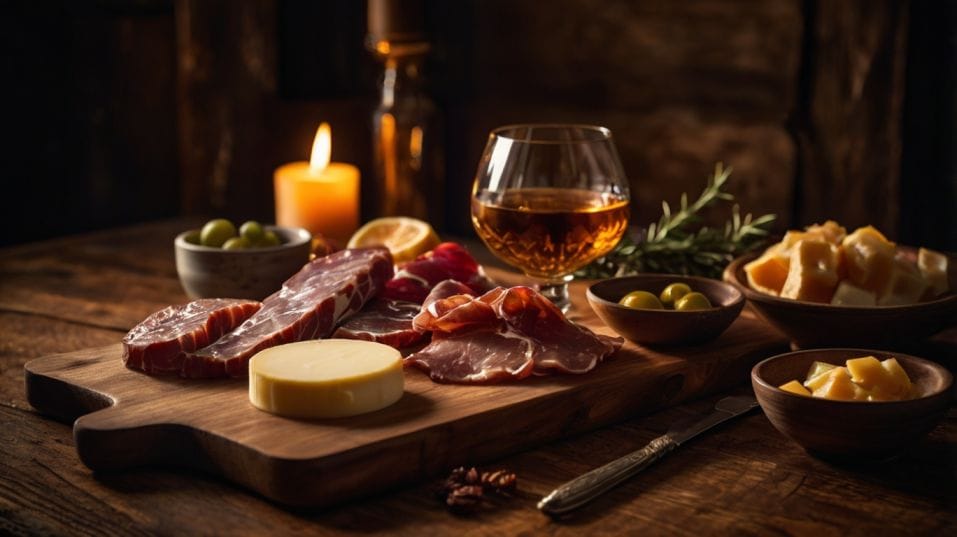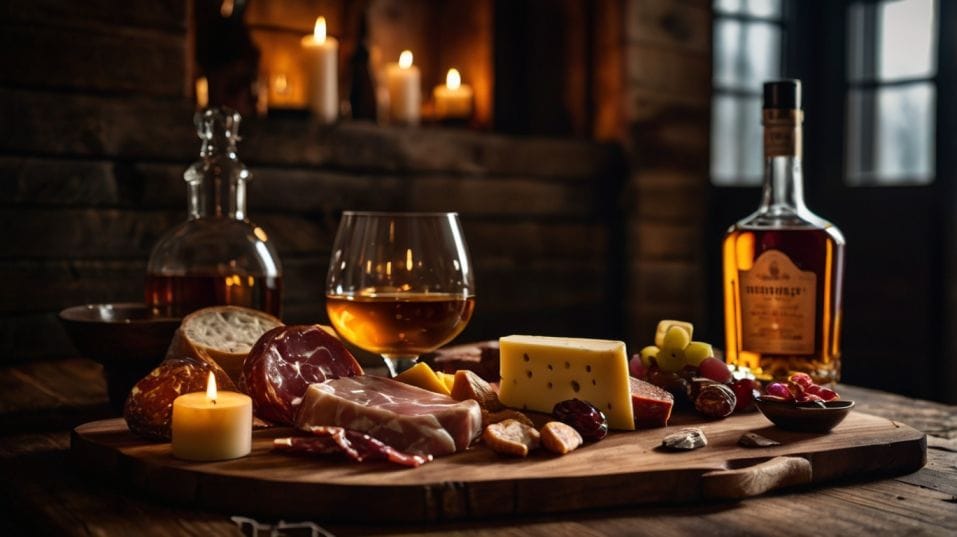The Ultimate Whiskey Charcuterie Board
Build a whiskey charcuterie board that trains your palate. Learn to taste better, pair smarter, and drink with purpose—no experience required.

What if your next whiskey pour could actually teach you something? A well-built charcuterie board isn’t just a stylish pairing—it’s a flavor lab.
For those new to whiskey, this is where the real learning starts. Every bite shifts the spirit, revealing hidden layers.
It’s not about having an expert palate—it’s about building one. With the right mix of foods, you’ll taste deeper, think sharper, and drink with intention.
Pairing Isn’t Decoration—It’s Calibration
Start here: whiskey reacts. To salt. To fat. To sugar. Every food element interacts with the structure of the spirit—alcohol, tannin, sweetness, acidity, esters, and more.
When you get the balance right, the whiskey opens up. Hidden spice, fruit, smoke, or grain character suddenly gets louder. Get it wrong and the pour flattens or burns. That’s not chemistry for its own sake. That’s tactical flavor training.
Salt brings sweetness forward, softens bitterness. Fat calms alcohol sting and extends finish. Acid (in pickles, mustards, or fruit) cuts through oily texture and resets the tongue. Sugar tames spice but can mute subtlety.
Bitter foods (dark chocolate, charred vegetables) reveal oak and earth in whiskey. Texture matters just as much: soft cheese versus brittle toffee, silky ham against astringent rye. You’re not just pairing tastes—you’re adjusting perception.
And perception is the gateway to discernment. Tasting with purpose reveals structure. You begin to decode whether a whiskey is round or edgy, fleeting or lingering, shy or expressive. A good board doesn’t mask flaws—it exposes them.

Structure Your Board with Intent
Don’t throw everything on the table. Chaos kills clarity. Instead, build categories that interact with whiskey in specific ways:
Salty/Fatty
Prosciutto, country ham, aged cheeses, smoked nuts. These boost sweetness, soften oak, and draw out baking spices in bourbons and rich Scotches.
Acidic/Bright
Cornichons, pickled onions, citrus segments, grainy mustard. Sharpness cuts through viscosity and helps leaner whiskeys like rye or Japanese malts pop.
Sweet/Soft
Dried figs, honeycomb, dark chocolate, candied nuts. Great for emphasizing fruit and vanilla in American whiskeys.
Bitter/Umami
Grilled mushrooms, seaweed snacks, olive tapenade, blue cheese. These pair best with peated Scotch or complex single malts, pushing smoky or savory elements forward.
Neutral/Reset
Plain crackers, breadsticks, raw almonds. Let your mouth reset. Not everything should compete. A few neutral bites in the mix restore balance and focus.
You want contrasts that build curiosity. A high-proof bourbon followed by a bite of bleu cheese doesn’t just shock your senses—it teaches you resilience.
Does the whiskey collapse? Transform? Hold its ground? These are the kinds of observations that train serious tasters.
Match Your Whiskey to the Board’s Tone
Different styles demand different support. Use the board to stretch your understanding, not to reinforce what you already know. Taste outside your comfort zone, and do it with a map.
Bourbon
Sweet, high-proof, oaky. Needs salt, fat, and dark bitter contrast. Try smoked meats, aged cheddar, or bitter chocolate. Notice how nutty elements bring out pecan or toffee notes, while charred meat dials up barrel spice.
Rye
Spicy, herbal, sharper edges. Play up acid and umami. Think mustard, pickles, pastrami, or briny cheese. Pair it with sourdough crisps or sauerkraut slaw to draw out minty or anise notes.
Scotch (Unpeated/Lightly Peated)
Delicate, malty, often fruity. Needs subtle, clean pairings. Mild charcuterie, fresh pear, soft bloomy rind cheese. Let the softer elements guide the tasting—look for orchard fruit, shortbread, or vanilla.
Heavily Peated Scotch
Smoky, oily, intense. Embrace big flavors: smoked almonds, anchovies, seaweed, grilled mushrooms. Anything too mild gets bulldozed. Instead, use char and umami to reveal complexity hidden behind the smoke.
Irish or Japanese Whiskeys
Often floral, silky, light-bodied. Avoid anything overpowering. Use gentle sweetness and subtle textures: poached pear, white chocolate, rice crackers. Clean, cold soba noodles or sesame snaps can also be surprisingly revealing.
If you mix multiple whiskey styles, break your board into mini-zones. Build little micro-pairing moments. Taste a wedge of manchego before your Speyside pour.
Sip a rye, follow it with a mustard-coated pretzel bite, then go back and see how the rye changes.
Taste Like a Collector, Not a Casual Drinker
Collectors don’t just chase bottles. They chase behavior. How a whiskey evolves under pressure. How it interacts with food, time, and temperature. A charcuterie board shows you which bottles have backbone, not just hype.
You start to see patterns: why high-rye bourbons stand up better to cured meat, or which malt finishes hold their own after strong cheese. You also learn what you actually like—not what reviewers claim you should.
Use the board as a tasting field guide. Write down reactions. Notice which whiskeys stay loud and structured through a gauntlet of flavor, and which ones fade. These observations separate the drinkers from the real collectors.
You build palate memory this way. That’s how you begin to anticipate a whiskey’s behavior before even opening it. And it makes buying smarter, not just more expensive.
Final Thoughts
This isn’t about fancy boards or curated posts. This is practical. Repeatable. Real. A whiskey charcuterie board is a tool to taste better, train sharper, and enjoy more deeply. You don’t need fanfare. You need attention, contrast, and a little structure.
So pick a whiskey. Build a board. Taste like you mean it. Train your senses, test your assumptions, and see what happens when you treat whiskey not as a spectacle—but as a system.
You’ll drink better. You’ll choose smarter. You’ll start building a whiskey experience that actually belongs to you. Start tonight. And tomorrow, build it better.




